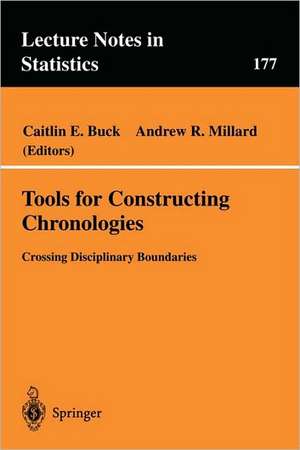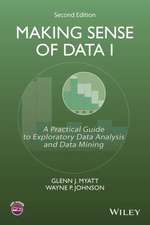Tools for Constructing Chronologies: Crossing Disciplinary Boundaries: Lecture Notes in Statistics, cartea 177
Editat de Caitlin E. Buck, Andrew R. Millarden Limba Engleză Paperback – 19 ian 2004
Din seria Lecture Notes in Statistics
- 15%
 Preț: 631.86 lei
Preț: 631.86 lei -
 Preț: 385.84 lei
Preț: 385.84 lei - 17%
 Preț: 490.19 lei
Preț: 490.19 lei - 17%
 Preț: 460.28 lei
Preț: 460.28 lei - 18%
 Preț: 945.92 lei
Preț: 945.92 lei - 20%
 Preț: 561.42 lei
Preț: 561.42 lei - 18%
 Preț: 943.25 lei
Preț: 943.25 lei - 18%
 Preț: 943.25 lei
Preț: 943.25 lei - 18%
 Preț: 995.97 lei
Preț: 995.97 lei - 15%
 Preț: 641.38 lei
Preț: 641.38 lei -
 Preț: 436.14 lei
Preț: 436.14 lei - 15%
 Preț: 633.53 lei
Preț: 633.53 lei - 15%
 Preț: 658.88 lei
Preț: 658.88 lei -
 Preț: 383.33 lei
Preț: 383.33 lei - 15%
 Preț: 640.71 lei
Preț: 640.71 lei - 18%
 Preț: 947.18 lei
Preț: 947.18 lei - 18%
 Preț: 1007.35 lei
Preț: 1007.35 lei - 18%
 Preț: 942.63 lei
Preț: 942.63 lei - 15%
 Preț: 639.59 lei
Preț: 639.59 lei - 18%
 Preț: 1231.47 lei
Preț: 1231.47 lei - 15%
 Preț: 643.00 lei
Preț: 643.00 lei - 18%
 Preț: 886.62 lei
Preț: 886.62 lei -
 Preț: 383.12 lei
Preț: 383.12 lei - 15%
 Preț: 633.35 lei
Preț: 633.35 lei - 15%
 Preț: 635.65 lei
Preț: 635.65 lei -
 Preț: 393.74 lei
Preț: 393.74 lei - 15%
 Preț: 632.70 lei
Preț: 632.70 lei - 15%
 Preț: 637.28 lei
Preț: 637.28 lei - 15%
 Preț: 702.87 lei
Preț: 702.87 lei - 15%
 Preț: 642.68 lei
Preț: 642.68 lei - 15%
 Preț: 644.63 lei
Preț: 644.63 lei - 15%
 Preț: 645.14 lei
Preț: 645.14 lei -
 Preț: 382.36 lei
Preț: 382.36 lei - 15%
 Preț: 636.30 lei
Preț: 636.30 lei - 15%
 Preț: 647.92 lei
Preț: 647.92 lei -
 Preț: 380.63 lei
Preț: 380.63 lei - 18%
 Preț: 887.05 lei
Preț: 887.05 lei - 15%
 Preț: 634.32 lei
Preț: 634.32 lei - 15%
 Preț: 648.74 lei
Preț: 648.74 lei -
 Preț: 378.92 lei
Preț: 378.92 lei - 15%
 Preț: 648.56 lei
Preț: 648.56 lei - 15%
 Preț: 647.59 lei
Preț: 647.59 lei - 18%
 Preț: 780.37 lei
Preț: 780.37 lei - 15%
 Preț: 641.20 lei
Preț: 641.20 lei - 18%
 Preț: 1102.69 lei
Preț: 1102.69 lei - 15%
 Preț: 643.16 lei
Preț: 643.16 lei -
 Preț: 384.70 lei
Preț: 384.70 lei
Preț: 423.84 lei
Nou
Puncte Express: 636
Preț estimativ în valută:
81.10€ • 84.89$ • 67.50£
81.10€ • 84.89$ • 67.50£
Carte tipărită la comandă
Livrare economică 31 martie-14 aprilie
Preluare comenzi: 021 569.72.76
Specificații
ISBN-13: 9781852337636
ISBN-10: 185233763X
Pagini: 284
Ilustrații: XIX, 260 p. 32 illus.
Dimensiuni: 155 x 235 x 15 mm
Greutate: 0.48 kg
Ediția:2004
Editura: SPRINGER LONDON
Colecția Springer
Seria Lecture Notes in Statistics
Locul publicării:London, United Kingdom
ISBN-10: 185233763X
Pagini: 284
Ilustrații: XIX, 260 p. 32 illus.
Dimensiuni: 155 x 235 x 15 mm
Greutate: 0.48 kg
Ediția:2004
Editura: SPRINGER LONDON
Colecția Springer
Seria Lecture Notes in Statistics
Locul publicării:London, United Kingdom
Public țintă
Professional/practitionerCuprins
1 Bayesian Chronological Data Interpretation: Where Now?.- 2 Pragmatic Bayesians: a Decade of Integrating Radiocarbon Dates into Chronological Models.- 3 Bayesian Inference of Calibration Curves: Application to Archaeomagnetism.- 4 The Synchronization of Civilizations in the Eastern Mediterranean in the Second Millennium BC: Natural Science Dating Attempts.- 5 Applications of Formal Model Choice to Archaeological Chronology Building.- 6 Complicated Relations and Blind Dating: Formal Analysis of Relative Chronological Structures.- 7 Genealogies from Time-Stamped Sequence Data.- 8 Tephrochronology and its Application to Late Quaternary Environmental Reconstruction, with Special Reference to the North Atlantic Islands.- 9 Constructing Chronologies of Sea-Level Change from Salt-Marsh Sediments.- 10 A Framework for Analysing Fossil Record Data.- 11 Taking Bayes Beyond Radiocarbon: Bayesian Approaches to Some Other Chronometric Methods.
Recenzii
From the reviews:
"Here's a good book on 'dating' that, luckily, won't find its way to the self-help section of your local bookstore!" Journal of the American Statistical Association, December 2005
"The main focus of the volume is a better analysis of chronological data … . The editors have done a good job … . I recommend reading the preface first to get the full benefit out of this volume. This volume is aimed towards applied statisticians, archaeologists, and geologists, among others. By reading this volume, one gets the feeling that statistics is a wonderful subject and is useful in many walks of life!" (Technometrics, Vol. 49 (2), 2007)
"This book provides techniques of extracting more information out of existing data. … is structured in a very interesting way. … many different scientific disciplines are covered throughout the book, providing real-life, and current examples with their associated problems. … the structure of this book allows statisticians to become familiar with this field … . one of the book’s greatest strengths is how it allows the reader to become completely involved in the construction of chronologies, thus promoting further thought and development in this area." (Alex Brink, SASA News, September, 2005)
"Taking my cue from the title of this book, the tools in question are statistical tools, principally Bayesian ones … . They present a useful overview in their preface and have made cross-links from one chapter to another. … What the book offers is a strong message that good statistical modeling is of huge assistance in building reliable chronologies and understanding their limitations, as well as calling for greater cross-fertilization between (sub)disciplines in respect of the statistical advances and tools … ." (M. C. Jones, Journal of the Royal Statistical Society, Vol. 168 (1), 2005)
"Here's a good book on 'dating' that, luckily, won't find its way to the self-help section of your local bookstore!" Journal of the American Statistical Association, December 2005
"The main focus of the volume is a better analysis of chronological data … . The editors have done a good job … . I recommend reading the preface first to get the full benefit out of this volume. This volume is aimed towards applied statisticians, archaeologists, and geologists, among others. By reading this volume, one gets the feeling that statistics is a wonderful subject and is useful in many walks of life!" (Technometrics, Vol. 49 (2), 2007)
"This book provides techniques of extracting more information out of existing data. … is structured in a very interesting way. … many different scientific disciplines are covered throughout the book, providing real-life, and current examples with their associated problems. … the structure of this book allows statisticians to become familiar with this field … . one of the book’s greatest strengths is how it allows the reader to become completely involved in the construction of chronologies, thus promoting further thought and development in this area." (Alex Brink, SASA News, September, 2005)
"Taking my cue from the title of this book, the tools in question are statistical tools, principally Bayesian ones … . They present a useful overview in their preface and have made cross-links from one chapter to another. … What the book offers is a strong message that good statistical modeling is of huge assistance in building reliable chronologies and understanding their limitations, as well as calling for greater cross-fertilization between (sub)disciplines in respect of the statistical advances and tools … ." (M. C. Jones, Journal of the Royal Statistical Society, Vol. 168 (1), 2005)
Caracteristici
The first book to group together and analyse all the chronology construction methods used in different disciplines Truly interdisciplinary and designed to enable cross fertilisation of techniques












